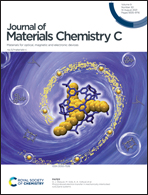In situ growth of polyoxometalate in COF for trace monitoring of Ag+ and hepatocellular carcinoma biomarker via a dual responsive strategy†
Abstract
Covalent organic frameworks (COFs) demonstrate a new trend in the field of chemical sensing mainly due to their potential for functional modification, defined pore environment and good chemical stability. Exploring functionalized-COF materials as chemosensors with low detection limits and high selectivity for biologically and environmentally important analytes is a campaign in this field. In this work, the incorporation of polyoxometalate (POM, Eu4W8) into the crystalline architecture a COF (EB-TFP) generates a functional composite material Eu4W8@EB-TFP. This material combines the merits of POM and COF together; it endows COF with outstanding luminescence properties and effectively broadens the sensing application of COF. It points out a new direction to employ POM-functionalized COF materials as efficient chemosensors to monitor trace amounts of Ag+ in environmental and CG (hepatocellular carcinoma biomarker) in biological systems. This work provides new insights into COF-based sensors and inspires the development of more versatile tools for analytical applications.



 Please wait while we load your content...
Please wait while we load your content...